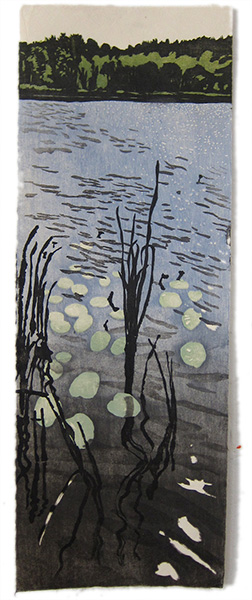Vitale Kunst - ein Gespräch
Von Bill Harrison, geschrieben anlässlich eines Gesprächs über Kunst nach dem Besuch einer Ausstellung von David Hockney

Looking at David Hockney’s charcoal landscapes, one is struck by their feeling of intimacy and connection. It is clear that the artist has opened himself completely to the subject of his work, that the process of drawing the scene before him was executed more in the spirit of conversation than in one of documentation or self-expression.
For two people in conversation to find true connection something new must be built between them. A simple exchange of already resolved ideas may be a form of conversation, but no connection is made and no transformation takes place. The creation of vital and moving art requires a similar quality of mutually creative interaction.
In the case of creating vital art, the artist experiences connection through meaningful conversation with either the scene, the subject, or with the medium. With representational art, such as Hockney’s landscapes, a new vision is built through the give and take between what the scene presents and what the artist creates. The artist doesn’t interpret the scene, but rather works in partnership with the scene. Together they produce something new. With abstract art, the conversation may be between the artist and the work itself, as it progresses. The artist guides the work just as the evolving artwork itself guides the artist. Throughout this open process both the artist and the artwork change and transform.
Vital art moves the viewer with this energy of transformation. The viewer is not subjected to the expression of an artist’s preconceived idea, vision, or image, but rather is invited into an open conversation. The viewer feels a sense of connection with the creative process, with the artist, and with the world.
Beim Betrachten von David Hockney's Kohlezeichnungen von Landschaften fühlt man sich getroffen von ihrer Ausstrahlung von Intimität und Beziehung. Es ist offensichtlich, dass der Künstler sich dem Subjekt seiner Arbeit ganz und gar geöffnet hat, und dass der Prozess des Zeichnens der Szene vor ihm mehr im Geist eines Gespräch stattfand als in dem von Dokumentation oder des Selbst-Ausdrucks.
Damit zwei Menschen im Gespräch eine wahre Verbindung zu einander finden, muss etwas Neues zwischen ihnen entstehen. Ein einfacher Austausch schon geklärter Ideen kann eine Form von Gespräch sein, aber es entsteht keine Verbindung und es findet keine Verwandlung statt. Das Schaffen von vitaler und bewegender Kunst erfordert eine ähnliche Qualität gegenseitiger kreativer Wechselbeziehung.
Beim Schaffen von lebendiger Kunst erfährt der Künstler ein Gefühl von Beziehung durch ein bedeutsames Gespräch mit der Szene, dem Thema oder der Technik. Im Fall von gegenständlicher Kunst, wie in Hockney's Landschaften, wird eine neue Sichtweise entwickelt durch das Geben und Nehmen zwischen dem, was die Szene zeigt und dem, was der Künstler daraus schafft. Er interpretiert weniger die Szene, sondern arbeitet partnerschaftlich mit ihr. Zusammen erzeugen sie etwas Neues. Im Fall abstrakter Kunst könnte das Gespräch stattfinden zwischen dem Künstler und der Arbeit selbst, während diese sich entwickelt. Der Künstler führt die Arbeit, während das sich entwickelnde Kunstwerk gleichzeitig den Künstler führt. In diesem offenen Prozess verändern und verwandeln sich beide, der Künstler und das Werk.
Lebendige Kunst bewegt den Betrachter durch diese Energie von Transformation. Der Betrachter ist nicht dem Ausdruck einer vom Künstler vorgefertigten Idee oder Vision unterworfen, sondern eher eingeladen zu einem offenen Gespräch. Der Betrachter fühlt eine Verbindung mit dem kreativen Prozess, mit dem Künstler, und mit der Welt.
San Francisco, Februar 2014

|